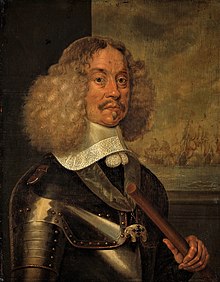Elephant Order
The Elephant Order is the highest and oldest Danish knightly order and, apart from custom-made items, the most elaborately crafted gem in the world.
history
The order was founded in 1462 as a brotherhood by King Christian I and sanctioned by the Pope, it was named Order of the Elephant . While some historical researchers put the order's original foundation on the year 1188 under King Knuth VI. date and others attribute it to King Erik VII (1412–1439), it is certain that the order of King Christian I was renewed in 1458. At that time it was still called the Brotherhood of the Virgin Mary . Because this brotherhood encroached on ecclesiastical areas - their highest goal was the defense of the Christian faith - King Christian I had his innovations confirmed by bulls from Popes Pius II (1462) and Sixtus IV (1474). At that time, the image of the Virgin Mary with the Christ child was hanging on the chain of the order . Famous early bearers of the order were Tycho Brahe and Heinrich Rantzau . Her portraits already show - around 1580 - an image of an elephant on an order chain.
The order was fundamentally changed by King Christian V , who issued new statutes in 1693. The number of knights has been reduced from 50 to 30, but the (eight) princes of the royal house are not counted as born knights . What is strange is the rule that the elephant order can only be awarded if the knight has already received the second Danish order, the Danebrog order . If he does not have it, it is given to the chosen knight eight days in advance. When receiving the elephant order, however, the Danebrog order must be taken off again, because no other order may be worn next to it.
In 1693, the year it was reorganized, the order was given its present form. The elephant is made of gold and, with the exception of the teeth ( ivory ), enamelled white. On one side he bears a cross, on the other the monogram of the ruling monarch . On his back is a blue, gold-framed ceiling, on the side of which there are five diamonds that form a cross, and there is a red tower with golden arched windows. A moor with a golden javelin sits on his neck as the elephant leader .
The motto of the order is: Magnanimi pretium (price of generosity)
There are two ways to wear the medal:
- The medal elephant is worn on a medal chain made of gold elephants with a blue blanket and gold towers on festive occasions.
- The order is one of the rare exceptions in which the shoulder strap is worn over the left shoulder so that the jewel hangs on the right hip.
When considering the elephant order, the question arises why this northern European country in particular chose the elephant as the symbol of its highest order. In the meantime, the elephant was not only highly revered in its southern home countries, but was also considered a symbol of wisdom and excellent qualities in Europe from early times . According to legend, a Danish warrior is said to have killed an elephant while fighting the Saracens during the Crusades . Hence it stands to reason that the elephant was chosen both as a symbol of wisdom and in memory of the Danish warrior.
In older sources, knights of the elephant order are also referred to as blue knights or blue knights .
Knight of the Elephant Order

Today the elephant order is almost exclusively awarded to members of the royal family and to foreign heads of state, the award of the order is decided solely by the queen, who is the mistress of the order.
It used to be bought by the nobility with money. This included Georg Albrecht from East Friesland, who had the medal incorporated into the coat of arms of the Marstall and paid for the medal, but did not raise the money to pay for the golden ironwork on the building. The Elephant Order was awarded to the last three ruling princes in East Frisia: Christian Eberhard (1682), Georg Albrecht (1722) and Karl Edzard (1734).
In addition to the high nobility of Europe and Asia, the order was also awarded to other personalities:
See also
literature
- JHF Berlien: The Elephant Order and its knights . Copenhagen 1846 ( digitized ). , ( Digitized version )


